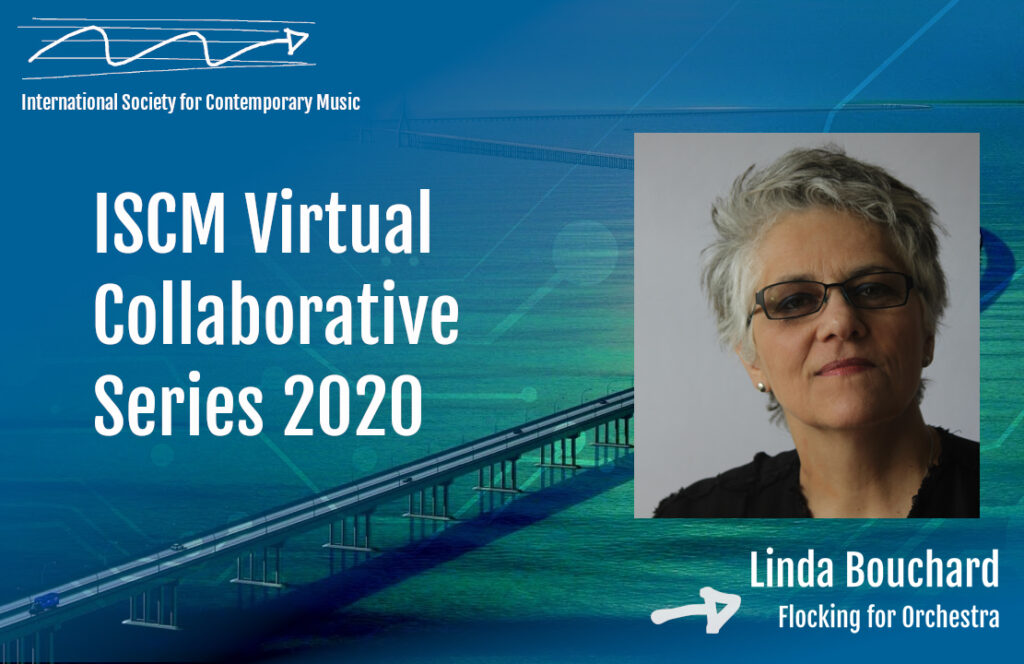Linda Bouchard: Flocking for Orchestra

(Submitted by ISCM – CANADIAN SECTION)
Linda Bouchard (b. 1957, Quebec) has been an active composer, orchestrator, conductor, and producer for over thirty-five years. Winner of both Composer of the Year from the Conseil Québecois de la Culture and the Joseph S. Stauffer Prize from the Canada Council for the Arts in 1999, Bouchard received the Fleck Fellowship from The Banff Centre in fall 2015. Her honors in the United States include first prizes at the Princeton Composition Contest, the Indiana State Competition, and the National Association of Composers USA Contest and a Fromm Music Foundation Award from Harvard University.
In 1977, Bouchard went to the United States to study composition with Henry Brant. She lived in New York City from 1979 to 1990, where she composed, led new music ensembles, and made orchestral arrangements for The Washington Ballet, Orchestra of St. Luke’s, and various churches in the New York metropolitan area. She was assistant conductor for New York Children’s Free Opera from 1985 to 1988 and guest-conducted Orchestra of St. Luke’s, the American Dance Festival, the New York New Music Ensemble, the Absolute Music Group, and The New Music Consort. In 1991, Bouchard returned to Montreal in time for the world premiere of her composition Elan with the Orchestre Métropolitain during the New Music America Festival. She was composer-in-residence from 1992 to 1995 with the National Arts Centre Orchestra in Ottawa, Canada, where she composed several orchestral works and curated new music events. In 1997, she moved to San Francisco, where she currently resides with her husband and her son.
For the past ten years Linda has been creating multimedia work while continuing to compose music for the concert hall. Her works Murderous Little World, All Caps No Space and Identity Theft have been performed in North America to critical acclaim.
About Flocking for Orchestra, Bouchard has written:
My compositions are defined by the importance of color and textures, and the structures of my works are intimately linked to the orchestral choices I make for each composition, be it a solo piece or a composition for full orchestra. I refer to this approach as Orchestration as Design. Composing from this perspective emphasizes the importance of timbres, color, and texture as structural principles in composition – the focus moves away from harmony and pitch systems to conceive of the continuous gesture of unfolding music in real time and stresses the perceptible experience of sound through a global approach instead of a sequential or cellular approach.
The term “flocking” typically references the complex behavior of birds coordinating their flight; it also refers to the texture produced by the process of depositing small fiber particles onto a surface. Over the course of my career, both of these processes have inspired several of my compositions, which use an intuitive method in response to these behaviors. For Flocking for Orchestra, I’ve integrated the interpretation of data in a flocking model to develop essential structural elements of the piece, including most of the pitch material.
For the past 15 years, I have been fascinated by the intersection of new technologies with traditional artistic practices and how they inform one another. Flocking for Orchestra allowed me to explore this idea more deeply, thanks to an Explore and Create grant I received from the Canada Council for the Arts. Starting in fall of 2017, I’ve had the privilege to work with Philippe Pasquier, Associate Professor at the Metacreation Lab: SIAT, Simon Fraser University in Vancouver, and Jeff Ens, an MSc student in his research group. Together we’ve created a tool that allows me to translate flocking simulation data into musical parameters.
For this piece, I associate the sudden changes in direction one finds in flocking behavior with contrasting orchestral textures. I use the axes of a 2-dimensional grid translating time duration on the X-axis and pitch and harmony on the Y-axis. This approach allowed me to produce a precise gestural outline within the overall tessitura of the orchestra. Occasionally, I used the spatial movement of sound on the stage going from left to right and vice versa. While digital tools and computation provided a frame for the composition and produced countless sketches, I still sat down with pencil and paper to compose the work.
Flocking for Orchestra is constructed in five sections expressing different viewpoints: inside the flock before takeoff (dense), airborne (flurries), slow motion (frozen photographic frames), vanishing points (horizon) and stillness. This work is dedicated to the Victoria Symphony Orchestra and Bill Linwood. I am grateful to have been chosen for the Davidson Commission Award.
Orchestre de la Francophonie conducted by Simon Rivard

ISCM
